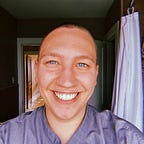This Is It Too
Each of us come to our work, come to our lives from an intersection of identities and experiences. Kimberle Crenshaw’s critical race theory of “intersectionality” specifically references the double bind of simultaneous racial and gender prejudice that affects all of us, with a particular focus on Black women and girls. A host of powerful teachers have helped me work with these ideas in my own life, in my work, in real time.
And tonight, I want to study and feel into the truth of this work being at once both theoretical, academic, professional, external, while also deeply personal and immediate. None of us can come to the work of maternal, parental, child, or family health as an impartial observer. Regardless of our current circumstances or families of origin or choice, we’ve all lived these ideas, these topics, these crises, these theories in one way or another.
Each of us were born. I say that not a philosophical way, but in a felt, fleshy way. Each of us transitioned from life in fluid, life inside another person’s body to life outside. Our birthdays—much more than legal information or social celebration—are, rather, embodied thresholds crossed at specific dates, times, and social locations that give us—each and every one of us—a meaningful stake in the health of birthing people and those they birth.
Health data is not only something to study, learn from, improve upon in our classes or nine-to-fives. It’s living, breathing information, in which we too are represented (or not). Take Apgar scores, for example, a tool used to assess an infants health at one and five minutes post-birth (and at additional five minute intervals for infants with scores lower than 7). This might be information that we come across in a data set, or a tool that we theorize on its efficacy, but it’s also likely a number that someone considered when they looked at you seconds, minutes after your birth as your eyes adjusted, as you wailed or stared or gasped for breath.
The personal lived experiences of global health—of parents and mothers and fathers; of babies and infants and toddlers and children; of pregnancy, birth, and postpartum; of death—are what keep me coming back to this work again and again and again. When we let our softness, our vulnerability, our own experience as parent or child or both match our scholarly rigor and scientific methods, I see the best work happen. May our policies and our studies and our surgeries always come back to this crossroads. This is it too. We are what we study and hope to change, create, and do in the world.
I’ll close with a list of questions from Carmen Winant, an artist whose work often centers on pregnancy and birth. These questions come from her series My Birth (2018) and have been a helpful tool to me in reflecting on both my own experiences and the broader elements of how we care for birthing people and parents. I find her words striking, beautiful, relentless and they serve as a potent reminder of the human-ness of birth in spite of and in the midst of all of the policies and procedures that shape our experiences.
Did you feel hunger?
Could you have imagined it?
Have you ever been that vulnerable?
Did the preparation help?
At which moment were you the most scared?
Did you ever fear for your life?
Has there ever been so much unknown?
Did you experience euphoria?
Did you experience orgasm?
Were you in control?
Were you thirsty?
Can you describe the quality of the pain?
Did you have the sense that you were giving birth to yourself?
Did you feel yourself tear open?
What did you regret?
Was the experience sacred?
At what moment were you at ease?
Has there ever been so much known?
Could you feel the hands inside of you (his and theirs)?
Did you feel that your body was working against you?
Did you feel brave?
Did you vomit?
Did you forget that you had vomited?
Did you wonder if it was really possible?
Did you think of your own mother?
Did you use a mirror to see it all?
Did you want to be alone?
Where did you sense the contractions?
Did you dim the lights?
Could you open your eyes?
Did you hear other women in labor, nearby (did you imagine them)?
Did you shit?
Have you ever been so exhausted?
What sensation did you experience with the cord being cut?
Did it give easily?
Did he feel like a stranger?
Did you look closely at your placenta?
Who touched his body first?
Did you weep?
What position was your body in?
Who was with you?
What was voluntary?
What number of hours did it take?
How many instruments were used on your body?
Were you cut open?
Did you tear?
Did he cry?
Were there medications used to counter other medications?
Could you see the reflection of yourself in your midwife’s glasses?
How many people were in the room?
Did they offer you comfort?
What did you do with your hands?
Were you totally naked?
How did it feel to create life?
